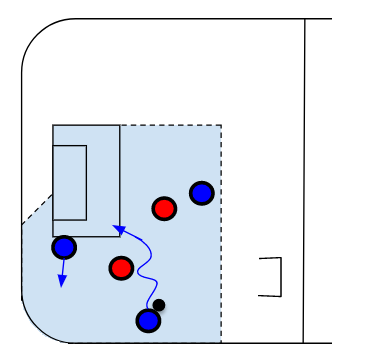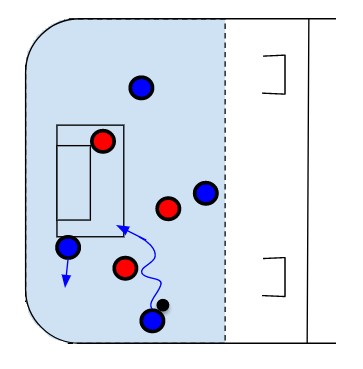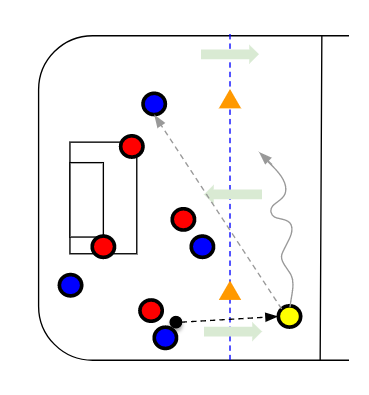A session of small sided games for teaching tactical game principles
Yesterday's blog post from Mikael de Anna (in finnish here) started a discourse on the actual practice design by coaches in different clubs. Here I will open up a very simple session from the SC Classic C1-juniors. We do most of our training by playing different game-based exercises that are built for learning the principles of play of our pretended way of playing.
These training games are meant to be played with high intensity to simulate a game of floorball. It is demanding physically, technically and engages the players emotionally (scoring and allowing goals). It also gives the opportunity to learn the know-how instead of know-what of the principles of play. The opponents will make the time and space limited and challenge the players somewhat as a match would. If we can express the desired way of playing fluently in these games, maybe some of it will transfer into a real game situation better than merely drawing and talking about the tactical decisions and training in isolation.
This kind of training makes it possible to simulate real game situations with a high frequency of the game situations we want to train. It is also repetition without repetition: the opponents are allowed to try their best to play against the other team. The desired situation will occur more frequently than in whole field 5vs5 play with stoppages and may be trained simultaneously on multiple zones on the training field. It preserves all the main moments of the game: offence, defence and the transitions. This is the core in our way of teaching players relationships in the game and perception-action. It is about learning “game intelligence” while training floorball fitness and technique in a real context.
SC Classic C1 3.10.2017 20:00-21:00, 20 players, 2 goalkeepers
Before the actual floorball training, we had a video meeting of the previous match and some warming up. On the training field, we usually have 2-5 minutes of free time for the players and after the training, 10-15 minutes of easy recovery activity, feedback, information about the next match and chilling together.
3v2 offensive zone play, corner/deep support. Both ends of the rink run same exercise. 2 x 6 shifts, 1 minute each.
This game situation might occur at least momentarily in a match: we have an overload on this part of field if the other defender is tied on the weak side and an forward is late from the situation or unable to drop below to defend one of our players

- Starts with a pass to the wing, one player deep, close to the goal and one player in the centre
- The ball carrier dribbles towards the goal/centre and attracts a defender
- This player must continue the movement also after a pass to the corner support.
- The player from the goal moves towards the corner to offer an easy passing option
- Try to score and transition to defending the mini-goal (counterpressing) if the defending team gets the ball.
- Starts with a new ball after a goal or if the ball goes off limits.
This principle of corner support is one of the important building blocks of our offensive zone play. Besides the positions and movements of the players in the exercise, the quality lies in manipulating the opposing defence. In order to build a good scoring change in this game situation, it is important to challenge the defenders with all the 3 attackers being continuously dangerous. A dribble may attract one defender to man-mark the ball carrier and after a pass to the corner, the new ball carrier might make a new quick dribble towards the goal, attracting also the second opponent to mark him. Either one of the dribbles is succesful or there is a free man in a scoring position if a pass may be completed. The players get to make their own creative actions to solve the problem according to these sub-principles:
- When a ball carrier is pressured in the wing of the offensive zone, a corner support must be offered to him
- After passing to the corner support, the player must move out of the way to make space for the deep support to move in to. He should try to dribble out of the corner and preferably towards the centre to present a threat to the defence, searching for a passing option to the centre or a new corner support if he is pressured.
This exercise could be expanded to run wider. Just add an offensive player to the weak side with the instruction to stay wide and be ready to score. A defender and a second mini-goal could be added to make it 4v3 to simulate the whole deep end of the offensive play. The mini-goals simulates a pass to the forwards for the red side, so they may also work on attacking againts a high pressing or a counterpressing opponent:

4v4+1 bottom support, 4 x 4 minutes
Effective and balanced offence has roles for each 5 players. In addition to the deep/corner support there should be options, so we also want the lowest player to offer a support below the wings when there is pressure. The supporting player must actively move to support the ball carrier close enough to the edges for a direct, clear passing lane.
For this (sub)principle, we built a game where there is a 4v4+1 running in each end of the rink. The space is limited with this many players in the deep zone, which forces the frequent use of the bottom support. This game was created by my assistant coach and brother Aleksi Hänninen.

In the game, the ball is allowed to travel as the green arrows show. The bottom support -player must move towards the edges to receive the pass down. The players are allowed to move on the whole half rink, so the defending team is allowed to press the bottom support and the offensive team may come down to offer support for him. This is a very simple game, where the play in the deeper end is a bit less organized. This makes the physical intensity high. We still wish to play according to our other principles also there, but it is not as directly controlled as the principle of the bottom support.
- Start with one team attacking, the other defending. The attacking team has the yellow player on their side.
- Ball may travel down and up the two zones according to the green arrows
- Players may move freely, you could also allow the bottom support to move in the deeper offensive zone and make the player change roles with him that passed down
- After receiving the pass, the bottom support should try to switch play or start moving towards the centre of the field while searching for an opportunity to get the ball back in by dribbling or passing.
- There should be width in the positioning of the attacking team when the ball is played down to the yellow player
5v5
The rest of the session consist of simply playing 5 against 5. First we start playing and observe how well the previous principles work. Then maybe stop the play and remind the players about them. The very end of the session is play without stoppages to observe the learning effect in less organized setting.
The principles in action in some video clips from our matches this season:
I am also open for discourse with other coaches who are interested or have opinions on this type of coaching.
Antti Hänninen (@AjHanninen)
